#Islam de France
Text
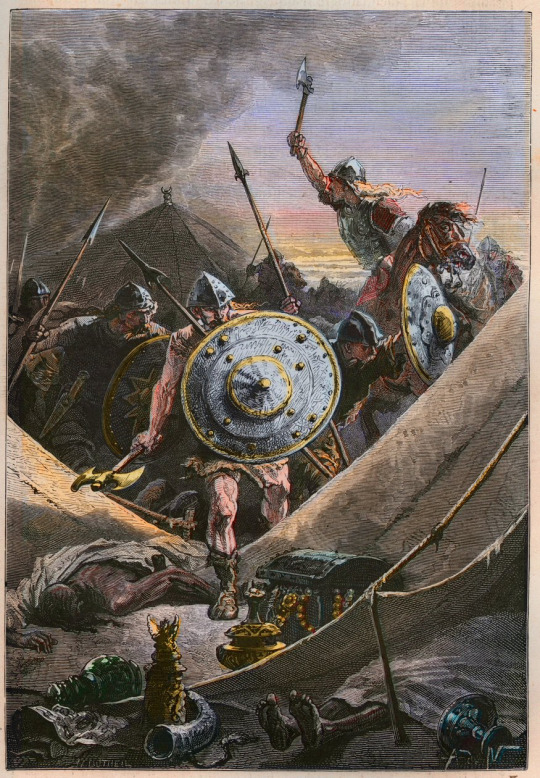
Attack on a Moorish camp - Defeat of the Saracens at the Battle of Tours, AD 732 — by Alphonse de Neuville
The Franks led by Charles Martel attack the Saracen camp at the Battle of Tours, halting the Muslim invasion in the year 732
#charles martel#battle of tours#battle of poitiers#franks#frankish#moors#invasion#germanic#france#art#alphonse de neuville#history#middle ages#medieval#europe#european#islam#muslim#christian#christianity#tent#battle#civilisation#civilization#western civilization#western civilisation#western europe#alphonse marie adolphe de neuville#french#treasure
178 notes
·
View notes
Text
Holaaaaaaaaaaaaaaaaa!
como están,porque yo mal 😤👊
esta mañana me desperté con dolor de cabeza, en el desayuno me quede sin cereales, tuve q hacer 3 examenes seguidos y ni me enteré de q había examen hoy, casi pierdo el celular, y me pegaron con la pelota 13 veces en educación física jugando al esquiva la pelota, me dieron con el stick(el palo de hockey 🏒) ,al volver a casa me regañaron por haberme olvidado dar de comer a mi perrita Yuki, y al entrar a instagram me doy cuenta de q hay perdí 50 followers 😡
porfavor díganme q no soy la única q ha tenido un día tan horrible 😔
se pone sad*
bueno dejando de lado el maldito día mierd* q tuve vamos a hablar de la mundial, quien creen q va a ganar en la final, argentina o Francia, yo la verdad quiero q gane argentina >:), pero también quiero q gane los franceses ;(, así q les pregunto a ustedes.
bueno sin más q decir

#world cup#qatar 2022#argentina#fifa world cup#france#mierda#Antes de la llegada del Islam#los habitantes de la Península Arábiga vivían en
9 notes
·
View notes
Text
Marion Maréchal, la femme politique française de 34 ans aux côtés d’Israël parle aux médias israéliens
Marion Maréchal, tête de liste au Parlement européen du parti d’extrême droite “Reconquête”, sait défrayer la chronique. Dimanche dernier, exactement une semaine avant les élections au Parlement européen, elle a déclaré que les subventions aux organisations de défense des droits LGBT devraient être supprimées. À cette occasion, elle s’est également prononcée contre le président Emmanuel Macron,…

View On WordPress
0 notes
Text
interdiction des abayas à l’école..

View On WordPress
#Abaya#école#France#frelons asiatiques#humour#interdiction des abayas à l’école#islam#Laïcité#liberté d&039;expression#qamis
0 notes
Text
Gare de Lille

1 note
·
View note
Text
Visuel-screenshot Wiki sur le nombre de conversions à l’Islam en France en général et annuellement. Le chiffre a doublé depuis 1 986.
BP.
(Aussi sur Fb, 23 mars 2 023)
#basile pesso#islam#france...#france#religions#contenu original#journalistes#sujets de société#sadness#tristesse#madness#écrivains#écrivains sur tumblr#journalistes indépendants#yes we are magazine
0 notes
Text
Créé cette année dans le cadre de la promotion des livres traitant de l’Islam à travers ses aspects les plus divers, ce prix récompense l’auteur d’un ouvrage dans les deux catégories Roman et Essai écrit en langue française et d’un ouvrage traduit en français publié par un éditeur entre le 1er septembre de l’année précédente et le 31 août de l’année en cours.
#rentrée littéraire 2022#littérature#théologie#religion#philosophie#prix littéraires 2022#récompenses#distinction#islam#islamologie#civilisation islamique#cultures islamiques#roman#essai#grande mosquée de paris#paris#france#jury#sélection#remise du prix
0 notes
Text
Not the former French prime minister preparing his presidential campaign and saying “maybe we have to admit that Islam needs specific rules and laws in France.” He also said that the 1905 law is probably not enough to “address the specificities of Islam” and that soon “specific laws and organization imposing certain obligations on Muslims only” will have to be put in place in the country.
He is basically saying “laïcité” (the freedom of religion and the state minding its own business) should not be applied to Muslims because we shouldn’t have the same freedom as other religious people in France. We should be controlled by the government.
When I saw that we are treated like colonial subjects this is what I’m talking about. They refused to apply “laïcité” (secularism) in Algeria under colonialism because it allowed them to control the indigenous population more.
If you’re North African, Black or Brown in France, even if you are not Muslim it will affect you. The plan is to treat us like colonial subjects. Under colonialism legally the term “muslim” didn’t even designate actual Muslims but “all indigenous people in Algeria”. There was such a thing as being a “Muslim Christian” because Islam was racialized to the point where it was considered to be an ethnicity.
The article in French here
Edit: The guy was invited at la Fete de l’huma 😂 dude’s plan is segregating Muslims but he was invited at the left wing gathering of the year. I’m laughing so I don’t cry.
#france#algeria#french islamophobia#racism#islamophobia#they are planning apartheid under our noses without any consequences#Neo colonialism#colonialism
1K notes
·
View notes
Text
A. Z. Fell & Co. bookshop and its statues
To start off, you have to be warned that the former set was almost completely destroyed in the S1 bookshop fire and whatever wasn’t important enough to be salvaged before the shooting had to be replaced afterwards. Which means that a few memorable and already identified pieces aren’t there anymore, for better or worse.
This is going to be another long analysis, and certainly not a full one — I’ll describe only the big picture and the most important props. A continuation focusing on the decorations in the less prominent parts of the bookshop will follow here.

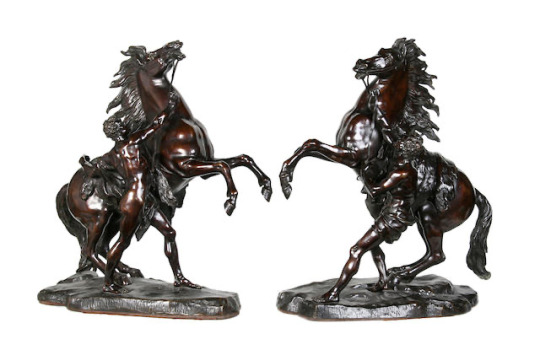
Right at the entrance we can see twin tables with the Marly Horses by Guillaume Coustou the Elder. The sculptures showing two rearing horses with their groom were originally commissioned by Louis XV of France for the entrance to château de Marly, a royal residence near Versailles.
In S2 Crowley is shown consistently using one of the horses, partially out of convenience, partially in line with a returning throughout the season dark horse theme. Ironically, the symbolic harnessing of a wild animal mirrors the supposed domestication of the demon by his angel, as seen in the transformation of the statue to the right from the entrance into an altar of his submission.
After all, there’s nothing more vulnerable to Crowley than losing the usual protection of his shades, and using a horse sculpture as a stand for his sunglasses speaks volumes about his natural aptitude towards uncertain and liminal states. He thrives in stress situations, dangles his feet while hopping onto a curb, and assumes the form of a non-Euclidean fluid when asked to sit down in a chair. Stability isn’t exactly what he’s most comfortable with. So what for Aziraphale signifies the power over his (theirs?) own domain and ultimate safe space, for Crowley means a challenge.
It makes sense that this particular spot near the exit is where the demon feels most secure in the bookshop, his favorite place in the world. That’s where he stood after crossing its threshold in 1941 too.

The statue in the middle, right on top of the central bookstand, was replaced after the S1 fire. It’s still clearly a Cupid, but in a different pose and without his weapons — instead of shooting an arrow, now he’s holding his left hand over his head, pointing up towards Heaven or God. Quite a change. This is the most similar copy made after Ernest Rancoulet. The butterfly-like wings (similar to the ones Rancoulet used in his La Nuit Tout Repose, At Night Everything Rests) on the copy in the bookshop have visible screws, so they were probably added either by the previous owner or the Good Omens art department.
What’s especially important from the analytic point of view is that similarly to S1, the Cupid in question still appears in the frame facing Crowley, but not targeting him anymore, like it used to, but rather mirroring. The most memorable example appears during the Final Fifteen™ when the demon points up with left hand to highlight his “No nightingales” line.
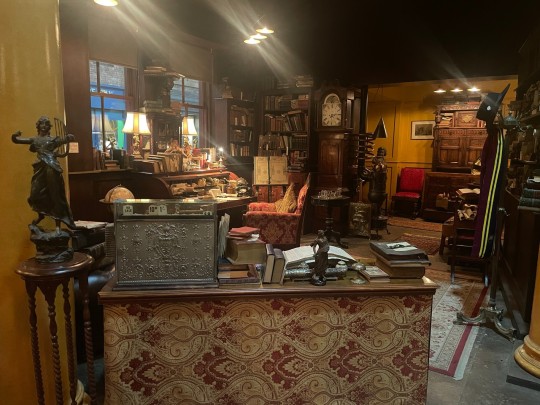
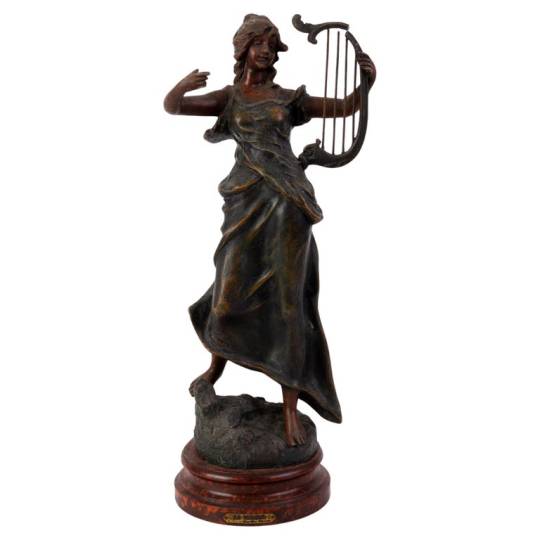
This one will be fun! Everyone, meet George Maxim’s bronze allegory of Music in her full glory. Angels like music in general, right? And Aziraphale is a known audiophile, which was asserted in the very first episode of the new season. But there’s another link to music in his angelic roots. A rather apocalyptic one — the Archangel Raphael is believed to blow the trumpet from a holy rock in Jerusalem to announce the Second Coming (the Day of Resurrection), and Israfil, its Islamic counterpart, Qiyamah (the Day of Judgment).
Staying in the very same context, let’s read the ballad Israfel by Edgar Allen Poe, which was obviously inspired by the titular Archangel.
Nothing on Earth lasts forever — but that’s exactly the reason why we should use it for inspiration, savor this momentary bliss, and hold it in our hearts. The ballad shares the same sentiment about all creation being temporary and only the passions of angels (i.e., Aziraphale’s and Crowley’s feelings) staying eternally unchanging as Aziraphale’s “Nothing lasts forever”. His line was intended as an affirmation of his feelings, similar to “You go too fast for me, Crowley”.
And just like the Cupid is mirroring Crowley in the “No nightingales” line, Music is targeting Aziraphale with her harp in the following frame.

On the counter there’s a smaller bronze statue, which original unfortunately remains unidentified, but I was able to track some similar designs. A woman coming back from the harvest with crops — either a representation of Autumn or the Greek goddess Demeter bringing a blessing of a plentiful harvest. In the Bible, the harvest is a metaphor for both spiritual fruitfulness and judgment. Our productivity in God’s kingdom is supposedly tied to our faith and obedience. And the most popular verses repeat an even older saying, how one reaps what they sow:
Do not be deceived: God is not mocked, for whatever one sows, that will he also reap. For the one who sows to his own flesh will from the flesh reap corruption, but the one who sows to the Spirit will from the Spirit reap eternal life. (Galatians 6:7-8)
And another angel came out of the temple, calling with a loud voice to him who sat on the cloud, “Put in your sickle, and reap, for the hour to reap has come, for the harvest of the earth is fully ripe.” (Revelation 14:15)
The harvest is past, the summer is ended, and we are not saved. (Jeremiah 8:20)
If you read The summer that was never supposed to end meta, you’ll interpret the figure itself as a rather ominous sign. Now let’s add to it positioning right next to the gigantic Victorian cash register one cannot possibly overlook and the recurring theme of payment. And the fact that it conveniently disappears at some point in The Ball (S02E05) episode, never to be seen again. Is the payment reminder not needed anymore, because its day just came?
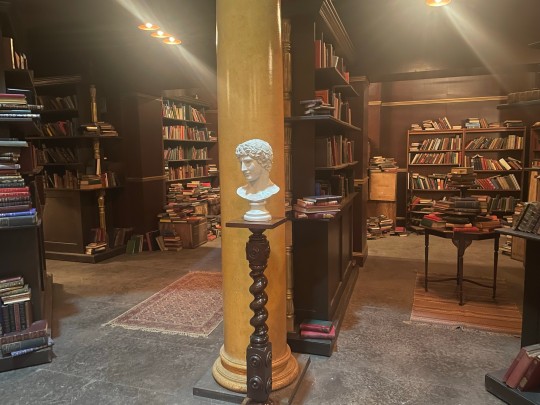
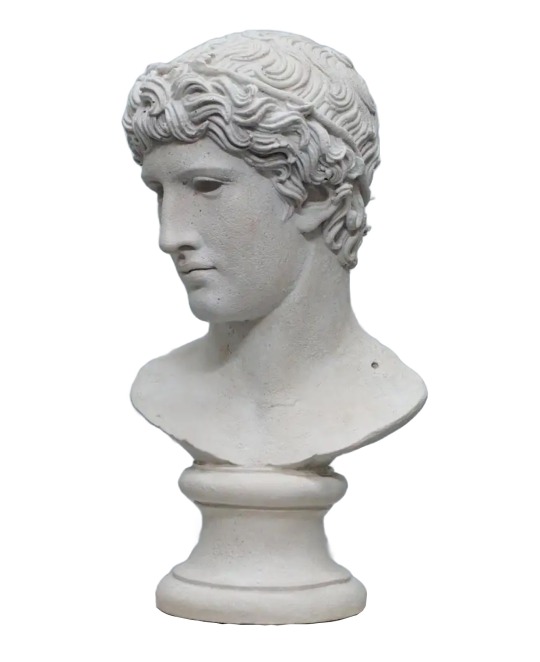
For some reason ever since S1 this one was often interpreted as a bust of Alexander the Great by the fandom. The proper name is the Head of a Victorious Athlete, also known as Benevento Head. As this suggests, the originally bronze sculpture represents a victorious athlete wearing an olive crown and was found near Benevento in Italy, in the remnants of the ancient town Herculaneum, wiped off from the face of the earth together with Pompeii in a tragic volcanic eruption (which was conveniently used later on as a more modern example of the story of Sodom and Gomorrah). It’s an obviously Roman copy of a Greek sculpture and dates back to 50 AD, less than a decade after Aziraphale and Crowley met in Rome in 41 AD— who knows, maybe they were still around at the time? This would make an interesting connection to the statue Crowley brought back to his apartment in 1941.
And no, in the HD quality and especially en face it doesn’t appear similar to Crowley. In fact, there seems to be a very good reason why most photographers choose another, more flattering angle for this particular artwork. But aesthetics aside, the white bust seems more like a mirror for Aziraphale and his self-constructed (and self-imposed) idealized image, based on a specific set of virtues. The presented athlete is victorious because he’s the epitome of the Platonic Triad of higher Forms: Truth, Beauty, and Excellence, understood in the wider context of the Greek Aretē.
To highlight this point, in S1 the head was literally used as a designated display place of the medal Aziraphale got as a commendation for his 6000 years on Earth in the 1800 cut scene. As a free agent not affiliated with Heaven in S2 he doesn’t hang it there anymore, but the medal is still in the bookshop, visible on his desk. You can see it in detail and read the description of its provenance in the last bookshop meta.
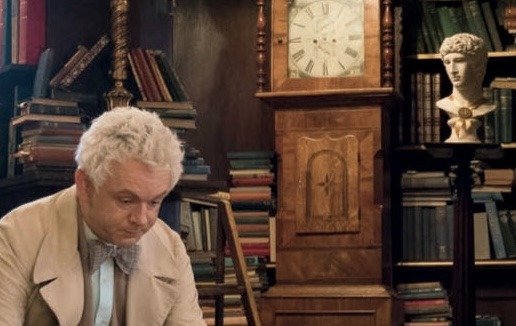
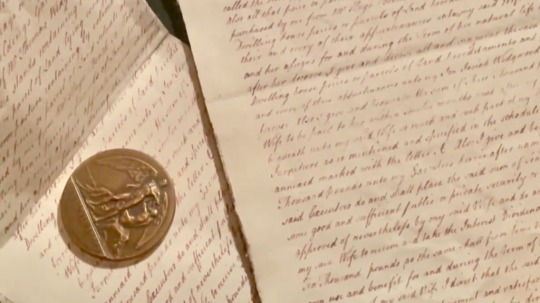
Daedalus and Icarus are a very popular motif in the history of art, but certainly not in this overtly masculine, military style. Icarus was too ambitious for his own good and ignored explicit instructions, which constitutes both the sin of pride and that of disobedience to one's parents (or one’s Creator?).
Interestingly, there’s also a version of the myth in which Icarus fashioned himself greater than Helios, the Sun himself, and the god himself punished him for it with the fall — which resonates very strongly with my vision of Crowley both in relation to his Fall and potential S3 development.
But back to Aziraphale. If the medal in question was given to him as a commendation he from the Supreme Archangel himself, it also serves as a warning for him to not get too arrogant or comfortable with his accomplishment (i.e., life on Earth) or it might lead to his fall (or, in this case, Fall).
Foreshadowing much?
#Yuri is doing her thing#good omens#good omens meta#A. Z. Fell & Co.#Aziraphale#Aziraphale’s bookshop#those art history classes weren’t a waste of time after all
325 notes
·
View notes
Text
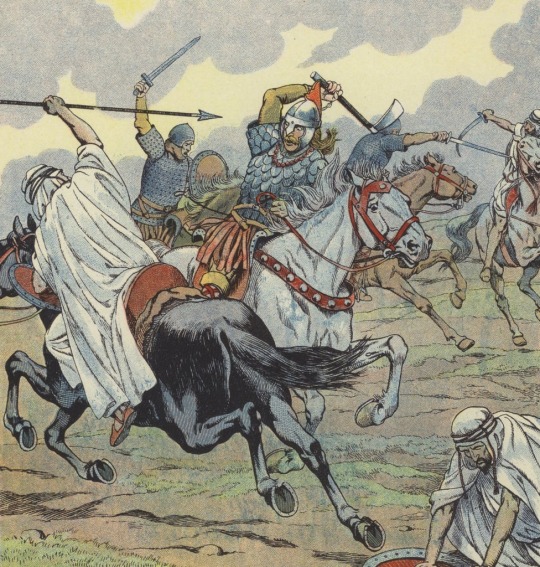
Charles Martel at the Battle of Poitiers, 732
by Jacques Onfroy de Bréville
#charles martel#battle of tours#battle of poitiers#art#jacques onfroy de bréville#job#franks#frankish#france#germanic#history#europe#european#medieval#middle ages#christianity#christian#islam#muslim#invasion#carolingian#knights#chivalry#civilisation#civilization#europeans#christians#muslims
144 notes
·
View notes
Note
hi! any reading you'd rec on bio politics\necro politics? i've recently gotten curious about the concepts so forgive if this is vague or not specific lol. tyy in advance ! hope ur day is good
so, the standard recs you will usually see for getting a theoretical foundation here are:
Foucault's 1978–9 lecture series at the Collège de France, "The Birth of biopolitics", and his 1975–6 series, "Society must be defended" (there are print series of his lectures) (<-these are honestly overrated as sources imho b/c foucault never fully developed these concepts. i would read lecture 11 from the 75–6 series if you absolutely feel you need some foucault, and then skip to whatever else seems interesting)
Achille Mbembe's Necropolitics (2019)
Jasbir Puar's The Right to Maim: Debility, Capacity, Disability (2017)
there are also lots and lots and lots of books that use concepts of bio/necropolitics in their historical and/or political arguments. some i've enjoyed include:
Joshua Cole, The Power of Large Numbers: Population, Politics, and Gender in Nineteenth-Century France (2018: Cornell University Press)
Daniel Nemser, Infrastructures of Race: Concentration and Biopolitics in Colonial Mexico (2017: University of Texas Press)
Andrew Aisenberg, Contagion: Disease, Government, and the "Social Question" in Nineteenth-Century France (1999)
Mie Nakachi, Replacing the Dead: The Politics of Reproduction in the Postwar Soviet Union (2021: Oxford University Press)
Banu Subramaniam, Holy Science: The Biopolitics of Hindu Nationalism (2019: University of Washington Press)
Kyla Schuller, The Biopolitics of Feeling: Race, Sex, and Science in the Nineteenth Century (2017: Duke University Press)
Michela Marcatelli, Naturalizing Inequality: Water, Race, and Biopolitics in South Africa (2021: University of Arizona Press)
Ellen Amster, Medicine and the saints: science, Islam, and the colonial encounter in Morocco, 1877-1956 (2013: University of Texas Press)
Ron Broglio, Beasts of Burden: Biopolitics, Labor, and Animal Life in British Romanticism (2017: SUNY Press) (<-doubles as an introduction into why the 'animal turn' has been such a hot topic historiographically in the past 5 or 6 years)
James Duncan, In the Shadows of the Tropics: Climate, Race and Biopower in Nineteenth Century Ceylon (2007: Ashgate)
René Dietrich & Kerstin Knopf (Eds.), Biopolitics, geopolitics, life: settler states and indigenous presence (2023) (<-haven't read this yet! some of these essays look very promising)
#book recs#biopolitics#there is also a very interesting chapter in nükhet varlık's book on ottoman empire & plague that makes an argument for usage of#the biopolitics framework centuries prior to the 'classic' 19thc case study. however varlık's book is very long and mostly not about that
122 notes
·
View notes
Text
Daily update post:
Another independent terrorist attack against Israeli civilians was carried out today, this time a vehicular one (where the terrorist tries to ram their vehicle into civilians on the street. This type of terrorist attack was first introduced in Israel, and then imported abroad. The deadliest one so far, was the vehicular terrorist attack in France, where at least 84 people were murdered). That's a small reminder that what happens in Israel, does NOT stay in Israel, and that terrorist attacks against Israelis should very much worry non-Israelis, too. What Hamas did on Oct 7 to our civilians, in their own homes, should terrify everyone, and not just for the sake of the victims. Today's 28 years old Palestinian terrorist, from Hebron, was unsuccessful in hurting anyone, and was eliminated himself.
The IDF has found, among other weapon caches, a truck full of long range rocckets, intended to be fired at Israeli civilians. Yesterday, I read a report that said the amount of weapons found in Gaza is so big, the army couldn't confiscate it all, and deliver it back to Israel, so instead, a lot of these weapons are being destroyed in Gaza itself, for example by running thousands of assault rifles over with tanks.

It's been reported that the president of MIT was under a lot of pressure from faculty and members of her administratoin to cancel a screening of the IDF's compilation of footage from the Hamas massacre on Oct 7. She insisted on not canceling it, and even attended the screening herself. People who were there, said she looked horrified, and had to look away from the screen at certain points. Will that make a chance in how antisemitism is treated on the MIT campus? I think it's important to listen to Jewish students on whether they see a real change on this. If they don't, she still needs to resign or be fired, just like the president of Harvard, and many other university presidents, who have been allowing antisemitism to thrive on their campuses for years.
Ritchie Torres might be my favorite American politician at the moment. I salute his moral clarity, his willingness to look at the conflict in depth instead of through a simplified prism that de-humanizes Jews, and his courage in speaking up for what's right, for Jewish people, and against antisemitism, even when he might pay a heavy price for that. He's been doing so consistently for years. This post he shared is absolutely horrifying, the 53% who think it should be okay to call for the genocide of Jews is SO telling. I'm grateful to Ritchie for calling this attitude out. If you can, please support him!

In my daily update post yesterday, I mentioned Jews needing police escort, because of anti-Israel protesters. Here is a Jewish activist speaking about Ayelet Levy, the mother of 19 years old Naama Levy (held hostage by Hamas), who came to NYC to talk about her daughter (you probably saw Naama, she was featured in one of the three most circulated vids of young Israeli women being kidnapped to Gaza on Oct 7), and the meeting was targeted by these anti-Israel protesters. It's pretty clear what has happened to Naama when she was kidnapped, and since. The people who attacked this meeting, who kept Ayelet from speaking for her victimized daughter, are literally working against the victim, and enabling her rapists and abusers. I don't think I have words for how morally distorted this is, all of it...
These are 47 years old Elad Katzir and 79 years old Gadi Mozes.

I mentioned in my daily update post yesterday, that Hamas released a vid with 3 captive men, to play with the minds and feelings of Israelis, and put even more pressure on our government, to give in. A short while after that, the Palestinian Islamic Jihad (PIJ) released a similar movie, with the two men pctured above. This shows once again how coordinated the Palestinian terrorist organizations in Gaza really are.
(for all of my updates and ask replies regarding Israel, click here)
#israel#antisemitism#israeli#israel news#israel under attack#israel under fire#israelunderattack#terrorism#anti terrorism#hamas#antisemitic#antisemites#jews#jew#judaism#jumblr#frumblr#jewish
70 notes
·
View notes
Text

Jacques-Albert Senave - Copyist in a gallery of the Louvre -
oil on panel, height: 28.5 cm (11.2 in); width: 36.2 cm (14.2 in)
Louvre Museum
The Louvre or the Louvre Museum is a national art museum in Paris, France. It is located on the Right Bank of the Seine in the city's 1st arrondissement (district or ward) and home to some of the most canonical works of Western art, including the Mona Lisa and the Venus de Milo. The museum is housed in the Louvre Palace, originally built in the late 12th to 13th century under Philip II. Remnants of the Medieval Louvre fortress are visible in the basement of the museum. Due to urban expansion, the fortress eventually lost its defensive function, and in 1546 Francis I converted it into the primary residence of the French kings.
The building was extended many times to form the present Louvre Palace. In 1682, Louis XIV chose the Palace of Versailles for his household, leaving the Louvre primarily as a place to display the royal collection, including, from 1692, a collection of ancient Greek and Roman sculpture. In 1692, the building was occupied by the Académie des Inscriptions et Belles-Lettres and the Académie Royale de Peinture et de Sculpture, which in 1699 held the first of a series of salons. The Académie remained at the Louvre for 100 years. During the French Revolution, the National Assembly decreed that the Louvre should be used as a museum to display the nation's masterpieces.
The museum opened on 10 August 1793 with an exhibition of 537 paintings, the majority of the works being royal and confiscated church property. Because of structural problems with the building, the museum was closed from 1796 until 1801. The collection was increased under Napoleon and the museum was renamed Musée Napoléon, but after Napoleon's abdication, many works seized by his armies were returned to their original owners. The collection was further increased during the reigns of Louis XVIII and Charles X, and during the Second French Empire the museum gained 20,000 pieces. Holdings have grown steadily through donations and bequests since the Third Republic. The collection is divided among eight curatorial departments: Egyptian Antiquities; Near Eastern Antiquities; Greek, Etruscan, and Roman Antiquities; Islamic Art; Sculpture; Decorative Arts; Paintings; Prints and Drawings.
The Musée du Louvre contains approximately 500,000 objects and displays 35,000 works of art in eight curatorial departments with more than 60,600 m2 (652,000 sq ft) dedicated to the permanent collection. The Louvre exhibits sculptures, objets d'art, paintings, drawings, and archaeological finds. At any given point in time, approximately 38,000 objects from prehistory to the 21st century are being exhibited over an area of 72,735 m2 (782,910 sq ft), making it the largest museum in the world. It received 8.9 million visitors in 2023, 14 percent more than in 2022, but still below the 10.1 million visitors in 2018, making it the most-visited museum in the world.
Jacques-Albert Senave (1758–1823) was a Flemish painter mainly active in Paris during the late 18th and early 19th centuries. He is known for his genre scenes, history paintings, landscapes, city views, market scenes and portraits.
28 notes
·
View notes
Text
Some of my favourite terminology for sex, sexuality, and gender that have mostly fell out of use:
Sapphist: Similar to the term Sapphic which is still in use, derived from the woman loving Greek poet Sappho. The -ist has implications of doing rather than being. A Sapphist is a woman who has romantic and sexual relationships with other women. It was commonly used in the 19th and early 20th century, eventually replaced by lesbian in common usage. Some famous historical figures who used this term include Vita Sackville-West, who also used the terms lesbian and homosexual.
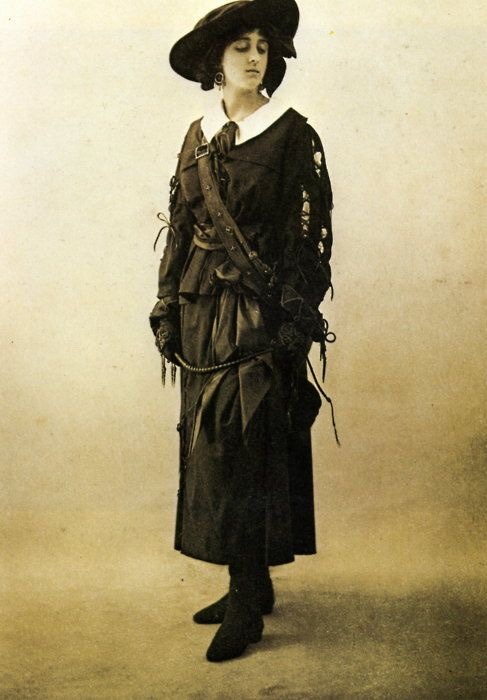
Mukhannathun: Translates roughly to "effeminate ones" or "ones who resemble women", typically refers to a feminine male, an intersex person, or one whose sex is indistinct. Modern scholars place the term Mukhannath in correlation with trans feminine. Mukhannathun traditionally took on the social roles of women in Saudi Arabia and feature in Ḥadīth Islamic literature. They were often musicians and entertainers, Abū ʿAbd al-Munʿim ʿĪsā ibn ʿAbd Allāh al-Dhāʾib (or Tuwais) being perhaps the first famous Mukhannath musician. I could not find any depictions of Mukannathun.
Invert: Sexology in the early 20th century believed that same sex desire and cross gender identification were natural in some people. It was coined in German by Karl Friedrich Otto Westphal (1833-1890) and translated across Europe and eventually into English as sexual inversion by John Addington Symonds Jr. (1840-1893) in 1883. Inverts were people whose natural sex instinct (heterosexual, cisgender) were "inverted", causing a natural desire for the same sex or to live as the other sex. It was thought that most inverts desired a relationship with a "normal" member of their own sex, for example a masculine presenting woman would desire a feminine presenting "normal" woman, a feminine presenting man would desire a masculine or "normal" man. While most sexologists thought sexual inversion was natural, they worried about corruption of "normal" people by inverts. The writer 'John' Radclyffe Hall (1880-1943) identified as an invert and explored the life of inverts in her 1928 novel The Well of Loneliness.
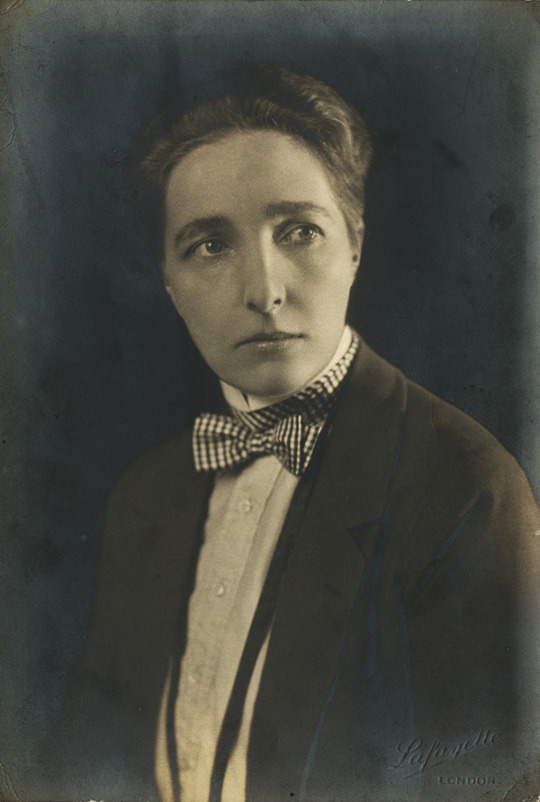
Uranism: A Uranian was a man who was romantically or sexually interested in other men. One of the earliest records of the term comes from Friedrich Schiller's 'Sixth Letter' in the Aesthetic Education of Man in 1795. It is derived from the ancient Greek goddess Aphrodite Urania, a manifestation of Aphrodite who was free of physical desire and instead was attracted by mind and soul. Ancient Greek literature was very important in the early formations of queer identity and self-recognition. Oscar Wilde (1854-1900) was known to use the term Uranian.
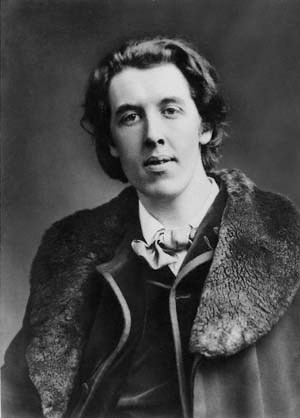
Tribadism: Derived from the Greek "tribas" which means "to rub", tribadism denotes both a sexual position (now known as tribbing or scissoring) and a woman who seeks to sexual dominate and/or penetrate another woman. This term could also be used to describe an intersex person who lives as female and is the penetrating partner during sex with women. It became the most common word to describe any kind of sexual intimacy between women in English literature from the 16th to 19th centuries. Marie Antoinette, queen of France from 1773 to 1792 was "defamed" in many anti-monarchist newspapers as being a tribade.

Eonism: Eonism was coined by English sexologist Havelock Ellis (1859-1939) to describe cross gender identification and presentation. "Eon" after the French diplomat Charlotte-Geneviève-Louise-Augusta-Andréa-Timothéa d'Éon de Beaumont, who was assigned male at birth but lived as a woman from 1777 until her death in 1810. Eonism was later replaced by transvestism in popular usage in the early to mid 20th century, coined by Magnus Hirschfeld (1868-1935) in 1910.
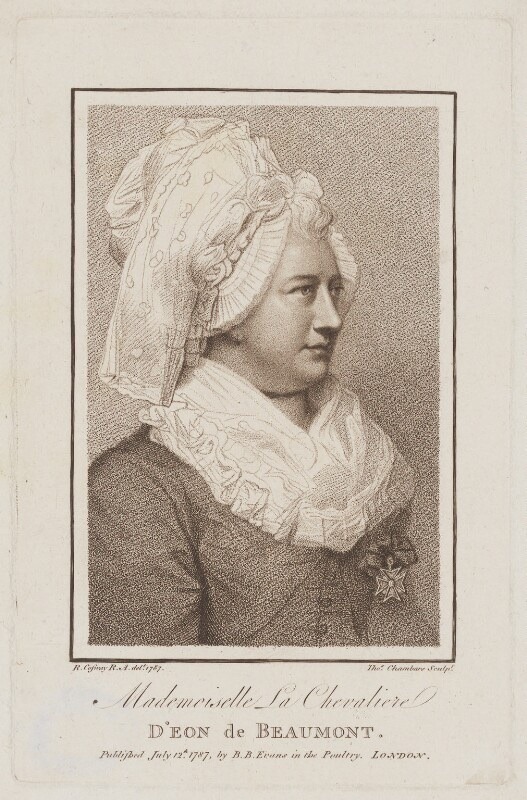
Eunuch: the term Eunuch has many connotations but the one common factor that almost all definitions share is that a eunuch is an intentionally castrated male. Eunuchs can also be uncastrated, but put into the social role as eunuch due to their 1) feminine presentation 2) inability to procreate 3) attraction to men. Eunuchs were not seen as men in most cultures, they were specifically chosen and castrated in order to fill a specific, separate social role from men and women. It was sometimes punitive, for example under Assyrian law men who were caught in sexual acts with other men were castrated. Eunuchs often had positions in royal households in the Ancient Middle East, their sexlessness was seen to enhance their loyalty to the crown as they were less likely to be distracted by sex or marriage, and it also allowed for jobs to be given on merit, and not inherited since Eunuchs could not reproduce. In Ancient Greece certain sects of male priests were eunuchs. China had Eunuchs who were fully castrated (penis and testicles) and high ranking in imperial service. In Vietnam, many eunuchs were self castrated in order to gain employment in the royal households.
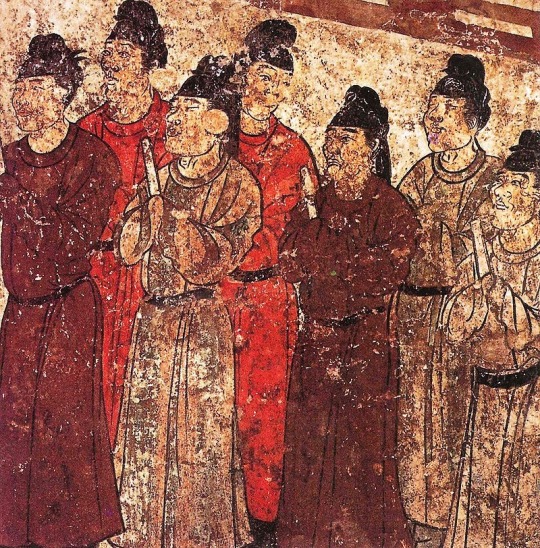
Homophile: coined in 1924 by Karl-Günther Heimsoth (1899-1933) in his dissertation Hetero- und Homophilie. The term was in common use in the 50s and 60s in gay activism groups. It was an alternative to homosexual coined in 1868 by Károly Mária Kertbeny (1824-1882) which was thought to have pathological and sexual implications, whereas homophile prioritised love and appreciation over the sex act or pathology. It is still in use in some parts of northern Europe. The Homophile Action League was founded by lesbian couple Ada Bello (1933-2023) and Carole Friedmann (1944-?) in Pennsylvania, U.S.A. in 1968, a year before the Stonewall Riots.
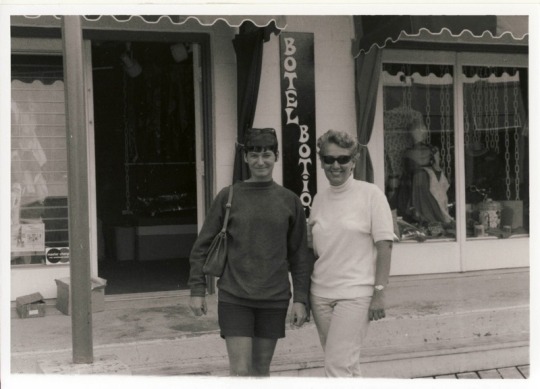
111 notes
·
View notes
Note
Please make more stories about Algerians taking over France, and French people having to be slaves and drinking their spit, becoming their wives, kissing and cuddling.
Your writing is incredible! It gets me so horny all the time. It’s truly a talent.


10 / 03/ 2024
ASK ANSWERED : EURABIA STORIES
Thanks for the question! I've wrote countless stories about Arabian/Muslim Domination. I wrote many stories featuring Arab men when the master's origin isn't specified, but most of the time they are supposed to be Algerians, or Turkish. Since i can only put 10 links, you'll find some stories abut what you asked in your public message.
I used to be excited by Arabian's domination but I'm more into the Black New World Order
It does not mean some Arabian men aren't hot, but they are divided between the ones who consider themselves French and wants to be part of the French society, and there is other who considers their mission is to enslaves French white people and there is even French white people who agree with it.

The Islamization of France is such a danger that there is many books about this topic 😱


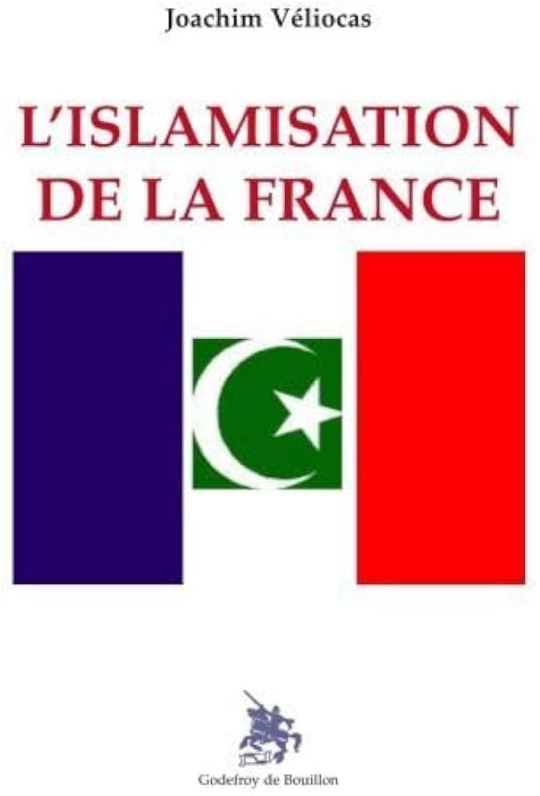
These drawings shows Muslim men as danger, because currently France is endangered by Muslims supremacists and the French white people who supports them

These drawings in French shows politicians serving Arabian men, licking their shoes to shows they prefer worshipping migrants and Muslim men rather than being patriotics.



If you are searching for stories about Eurabia and France being ruled by Muslims, this is the one you must read. It's one of my longest and favorite stories. 😉 It's a story where I imagined President Emmanuel Macron being in love with his former bodyguard, Alexandre Benalla, who have Maroccan's parents. In this long and detailed story, with a lot of sadism and humiliation, i imagined how Muslims people would take power in France :
A story where whitebois from the French Football Team, especially Antoine Griezman, are enslaved by Arabian and Blacks teammates. Eurabia is described because it is supposed to takes place when Alexandre Benalla have taken power over France
A French white family enslaved by Arab men
Another story where an Algerian family enslaves a French white family, and the boy is married to the Muslim man at the end :
A French white gay couple enslaved by an Algerian /Muslim family. One of the French whitebois is married and feminized :
I include this story which isn't about a French man but about an English boy. However, since he is feminized and forced to serve Muslim men, it's related to what you enjoy. I really appreciated writing this story, because Anjem Choudhary is hot for a Muslim man 😁
A French whiteboy in high school enslaved by his dominant Muslim schoolmates :
Another story about a French boy enslaved since France is ruled by Arabians / Muslims
A question I've been asked about Muslim men, with links of stories about them 😀
An Algerian gay couple served by an old French white man when they are in Algeria :
I wrote many others stories about Muslim domination, but i hope you'll like them 😊 Please don't hesitate to like, reblog and comment them if you appreciated my stories
@eurogirlsdestruction @maitresrebeux @muslimdomination4europe @rebeuarab @muslimfeet @arabiandomination-blog @muslimsfuckeuropeanwomen @eurabiansubject @whiteslavetoblack @arabslavemasters @arabicadmirer @tidodore2 @rainykpoptravelcreator @lovefanfiction01 @gayhopefullove @leftprogrammingroadtripdean
35 notes
·
View notes
Text
As I promised, let's start with the bookscans:
Al-ANDALUS. PERSONAJES HISTÓRICOS
(Al Andalus. Historical figures)
Concepción Masiá
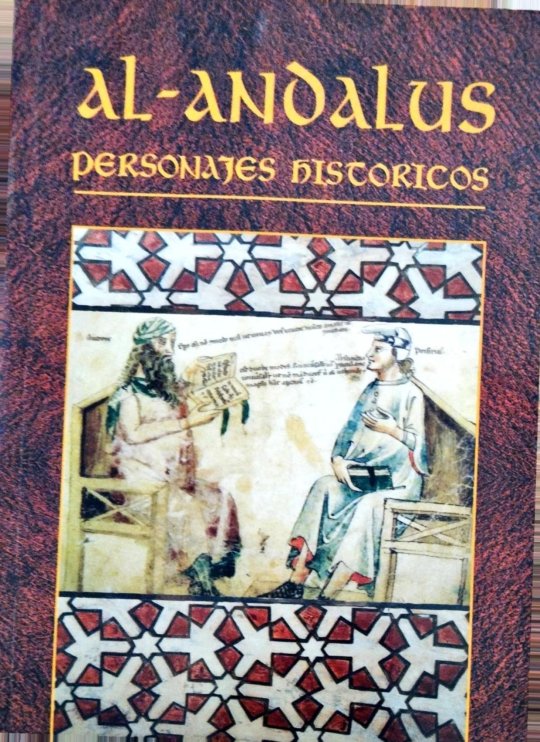
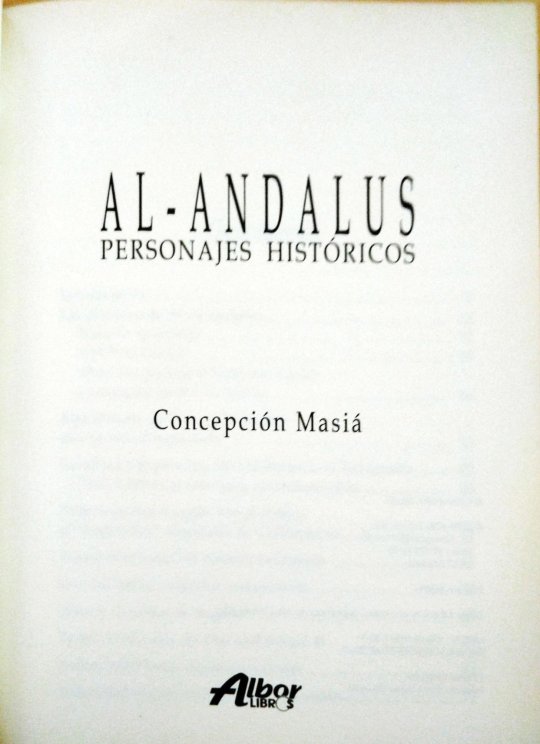

Summary
Introduction.................................. 9
The precursors of al-Andalus.....13
Count Don Julián....................13
Tarif ben Malluk. ....................15
Musa ben Nusayr and Tariq ben Ziyad: the conquerors of Spania...........16
Abd al-Aziz: a good governor with an unfortunate fate ..........................25
The Odyssey of Prince Abd al-Rahman the Immigrant......................................29
Abd al-Rahman was only twenty-five years old.........................................36
Sulayman ben Yaqzan ben al-Arabi: Charlemagne's deceived "deceiver" ........................... ...........41
Amrus ben Yusuf: the muladí of Huesca
.............................................................47
The “rabadies”: adventurous spirits.. ..............................................53
Ziryab: the singer of Baghdad........61
Tarub: the favorite of Abd al-Rahman II...............,...........................................67
Abbas ben Firnas: the first aviator............................ ......................73
Yahya ben Hakan al-Bakri: the miserly poet.....................................................77

Abd al Chabbar and Sulayman ben Martin: the rebels of Mérida..........................81
Eulogio and Álvaro de Córdoba:
pursuing martyrdom..........................85
The Andalusian Vikings..................... 95
The emir Abd Allah distrust and death...............................….................... 101
Musa ben Musa ben Qasi: the third king of Spain.......................................................107
Ibn Hafsun: the unredeemed rebel.....115
Abu Alí al-Sarrach: the Andalusian missionary. ...........................................125
Ibn Masarra: a freethinker in Spanish Islam.......,...........,...................................131
Abd al-Rahman III:
the first independent caliph of al-Andalus. ...........,................................137
Hasday ibn Shaprut:
the Jewish doctor of Abd al-Rahman III............ ....... ...................... ................... 145
Andalusians in France: the “Moorish kingdom” of Fraxinetum....................... 151
Rabbi ben Zayd: Bishop Recemundo............................................. 157
Al-Hakam al-Mustansir bi-llah:
passion for culture.................................. 161
Ibn Abd Rabbhi, the encyclopedist,
and Ibn Futais, the collector.................. 167
Al-Mansur “the Victorious” ...................171
Hisham II and Sanchuelo: misrule. .......191
Abu Muhammad Ali ibn Hazm:
The pigeon neackle................................209
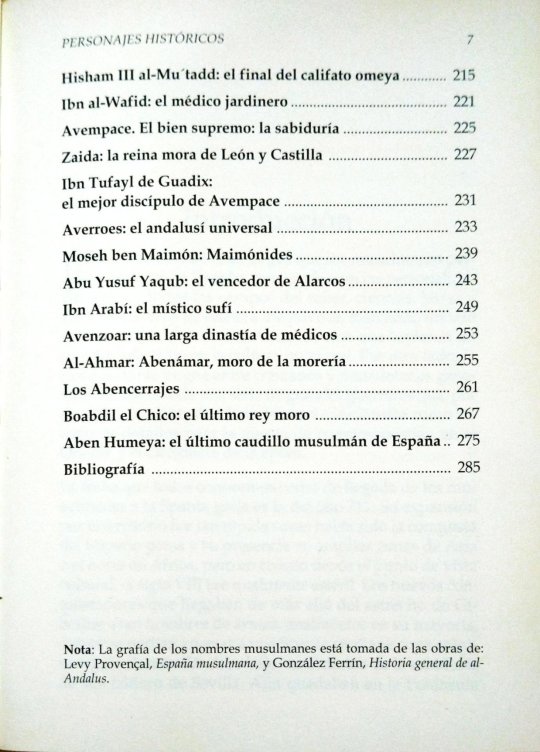
Hisham III al-Mu'tadd: the end of the Umayyad caliphate...............................215
Ibn al-Wafid: the gardener doctor.....221
Avempace. The supreme good: wisdom...................................................225
Zaida: the Moorish Queen of Leon and Castile........................................................227
Ibn Tufayl of Guadix:
the best disciple of Avempace................. ............................ .231
Averroes: the universal Andalusian....233
Moseh ben Maimon: Maimonides..... ..239
Abu Yusuf Yaqub: the winner of Alarcos......................................................243
Ibn Arabi: the Sufi mystic.....................249
Avenzoar: a long dynasty of doctors. ...................................................253
Al-Ahmar: Abenámar, Moor of the Morería. ...,...............................................255
The Abencerrajes. ..................................261
Boabdil the Younger: the last Moorish king ............................................................267
Aben Humeya: the last Muslim leader of Spain................ ..........................................275
Bibliography .............................................285
Note: The spelling of Muslim names is taken from the works of: Levy Provençal,
Muslim Spain, and González Ferrín, General History of al-Andalus.

Introduction
In the long eight hundred years that the Muslims remained in Spain, there were many personalities who, in all the fields of knowledge, sciences, letters and arts, stood out unequivocal, marking a milestone not only in the culture of al-Andalus, but that had a relevant character in universal culture.
On the other hand, the almost constant struggle between Christians and Muslims would also generate a whole series of great warriors who, for example, the infante Don Juan Manuel considered the best gifted for the war of all those who existed in the East and the West of their time.
The date that we all know as the arrival of the Muslims to Gothic Spania dates back to the year 711. Its expansion throughout the territory was so rapid as had been the conquest of the Persian empire and its presencein large areas of Asia or North Africa, but from a cultural point of view, the 8th century was totally sterile. The new conquerors who arrived from beyond the Strait of Gibraltar, were men at arms, mostly illiterate, who could do little contribute to a Christian Spania whose culture continued to develop under the dictates of the wisdom of Saint Isidore of Seville. Still they were left on the Peninsula
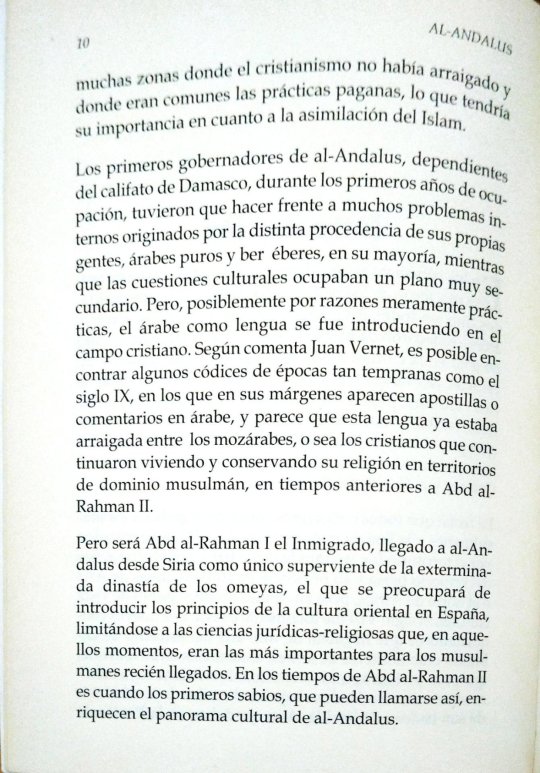
many areas where Christianity had not taken root and its importance regarding the assimilation of Islam.
The first governors of al-Andalus, dependent on Caliphate of Damascus, during the first years of occupation
had to face many enormous internal problems, originated by the different origins of their own people, Arabs
and berebers, mostly, while cultural issues occupied a very secondary level. But, possibly for purely practical reasons, Arabic as a language was introduced into the Christian field. According to Juan Vernet, it is possible to find
some codices from times as early as the 9th century, that in its margins appear apostilles or comments in Arabic,
and it seems that this language was already rooted among the Mozarabs,
that is, the Christians who continued to live and preserve their religion in Muslim-dominated territories, in times
before Abd al-Rahman II.
But it will be Abd al-Rahman I the Immigrant, who arrived in al-Andalus from Syria as the only survivor of the exterminated Umayyad dynasty, the one who will be concerned with introducing the principles of oriental culture in
Spain, limiting itself to the legal-religious sciences that, in those moments, were the most important for the newly Muslims
arrived. It was during the time of Abd al-Rahman II that the first wise men, who can be called that, enrich the cultural landscape of al-Andalus.

Poets, doctors, philosophers, mathematicians, geographers, undefeated generals...All of them will give al-Andalus and Europe a series of works that, by their importance will be translated, searched, accepted and will serve as a basis for the western culture and Renaissance ideas, in such a way that many of the great sages of the Italian Renaissance considered that all knowledge of the time came from Muslim Spain, which all the wise men were of Andalusian origin. And when the political decline and the disintegration of the caliphate, will not stop birth, grow and develop distinguished minds that will continue to maintain,for a long time, the prestige of al-Andalus. Curiously, this situation will be repeated throughout the history of Spain, when the Arab occupation just be a memory. The Spanish Golden Age will coincide with decadence of the Austrias, when the country loses its pre-ponderance in Europe, and with the disaster of '98, with the loss for Spain of its last colonies, will produce a cultural and scientific renaissance that has been called the Silver age.
Through the pages of this book we want to highlight those figures who occupied a predominant place in the history of al-Andalus, although not all of them were necessarily Muslims, since that in that cultured and tolerant al-Andalus, many Jews and some other Christians showed their genius, and of those who, often, we know more about his works than about his biography. But whatever religion they had, they were all, after all, Andalusians, born and raised in the extensive lands of al-Andalus. As a matter of curiosity we will include some groups of characters
anonymous people who, due to their surprising
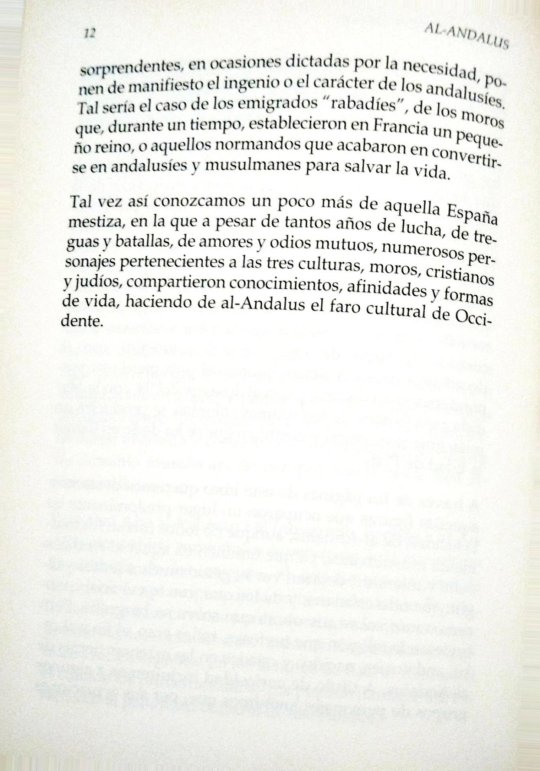
actions, on occasions dictated by necessity, they reveal the ingenuity or character of the Andalusians. Such would be the case of the "rabadíes", of the Moors who, for a time, established a small kingdom in France, or those Normans who ended up becoming Andalusians and Muslims to save their lives.
Perhaps this way we will learn a little more about that crossbred Spain, in which despite so many years of struggle, truces and battles, mutual loves and hates, numerous characters belonging to the three cultures, Moors, Christians and Jews shared knowledge, affinities and forms of
life, making al-Andalus the cultural beacon of the West.

The precursors of al-Andalus
Count Don Julián
The conquest of Morocco had been carried out quickly, but shallow. The Berbers were only subdued after a fierce resistance, defeated by an ambitious general who had just been appointed governor of Ifriqiya and Maghrib. His successes in these lands
They would prepare the ground for him to be the one to set his eyes and, also
his troops, over Gothic Spania. It was Musa ben Nusayr.
Musa, with the help of one of his sons, took possession of Tangier, and demanded that the subjugated tribes hostage to educate them in the new faith, which in turn, became propagandists of Islam, leaving in the conquered Morocco
Arab lieutenants, including General Tariq ben Ziyad, he turned to Ifriqiya. But it seems that the Ceuta square remained
in the hands of a Christian, the so-called Count Don Julián, who would have a
determining role in this entire story. We could consider it as a precursor of that al-Andalus that was about to be born.
#bookblr#book scans#historyblr#history books#al andalus#al andalus. personajes históricos#al andalus. historical figures#history#spanish history#musa ibn nusayr#tariq ibn ziyad#conde don julián#count don julián#count julian
27 notes
·
View notes